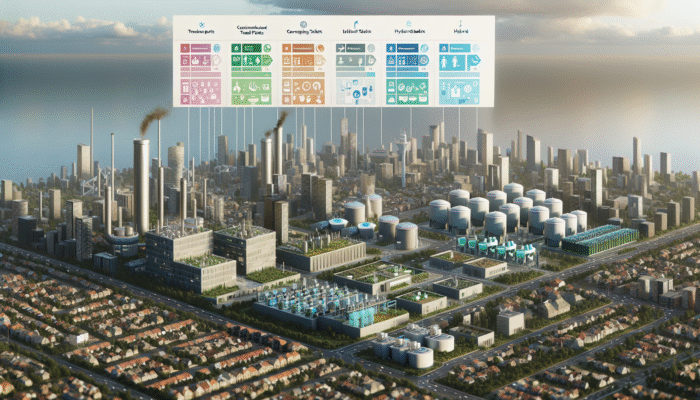Exploring the Essential Impact of Sanitation in Urban Environments
Effective Urban sanitation strategies are vital for promoting the health and economic sustainability of cities. The importance of sanitation extends beyond just public health; it is integral to environmental protection and fostering economic growth. Urban centers, characterized by high population density and significant waste production, face unique challenges that require innovative and eco-friendly sanitation solutions. By delving into the various advantages linked to robust sanitation systems, we can gain a deeper understanding of its essential role in the urban planning and development process.
Boosting Public Health Through Comprehensive Sanitation Infrastructure

At the core of successful urban sanitation strategies is their significant impact on public health. In high-density urban settings, the rapid spread of infectious diseases poses a major challenge, highlighting the urgent need for resilient sanitation systems to prevent health crises. Areas with inadequate sanitation infrastructure often witness spikes in diseases such as cholera, dysentery, and typhoid fever. The World Health Organization (WHO) emphasizes that improving sanitation can lead to a dramatic reduction in such illnesses, greatly enhancing health outcomes for city dwellers.
Moreover, ensuring access to clean and safe sanitation facilities reduces the risk of exposure to harmful pathogens, which is directly linked to lower rates of morbidity and mortality. Vulnerable populations, such as children, the elderly, and those with compromised immune systems, are at greater risk, making it imperative for city planners to prioritize sanitation infrastructure that safeguards these groups. By investing in comprehensive sanitation practices, cities can address urgent public health issues while elevating residents’ quality of life, ultimately fostering healthier and more resilient urban communities.
Evaluating the Environmental Consequences of Poor Sanitation
The environmental consequences of inadequate sanitation are considerable, often leading to the pollution of water bodies, deterioration of soil quality, and a decline in biodiversity. Urban areas produce vast quantities of waste, and without proper management, this waste can contaminate vital natural resources, adversely affecting both ecosystems and human health. Sustainable urban sanitation strategies are crucial for mitigating these environmental issues by implementing waste treatment processes that protect our planet.
For example, a city that adopts a comprehensive waste management approach can significantly minimize the amount of waste sent to landfills, which in turn helps reduce greenhouse gas emissions. Utilizing systems that recycle wastewater for reuse demonstrates how urban areas can conserve valuable water resources, especially in today’s climate-sensitive landscape. By placing a strong emphasis on environmentally friendly practices within sanitation management, cities can preserve natural ecosystems and ensure that urban environments remain livable for future generations.
Realizing Economic Benefits Through Strategic Sanitation Investments
Investing in sanitation yields substantial economic benefits that are often overlooked amid urgent immediate needs. Poor sanitation incurs increasing healthcare costs due to disease management, productivity losses from illness, and a general decline in quality of life, all of which hinder economic advancement. Research indicates that for every dollar invested in sanitation, cities can expect a return of around $5 in economic benefits, primarily through reduced healthcare costs and improved workforce productivity.
Furthermore, urban centers that prioritize urban sanitation strategies become more attractive for investment and tourism, as well-managed urban spaces with clean environments draw in both businesses and visitors. This creates a positive feedback loop where enhanced sanitation spurs economic growth, which then leads to further investment in sanitation and urban infrastructure. As cities worldwide grapple with rapid urbanization, recognizing sanitation as a key economic driver is essential for sustainable development.
Investigating Various Models of Sanitation Systems

A comprehensive grasp of the different sanitation systems available is essential for effectively implementing urban sanitation strategies. Each system presents unique benefits and challenges, with the selection often influenced by factors such as population density, resource availability, and local conditions. By categorizing sanitation systems into centralized, decentralized, and hybrid models, urban planners can develop tailored solutions that meet the specific needs of their communities.
Centralized Sanitation Systems: Maximizing Efficiency in Urban Environments
Centralized sanitation systems are structured to collect and manage waste at a central location, making them particularly effective for densely populated urban areas. These systems typically consist of extensive sewer networks that transport wastewater to treatment facilities, where it undergoes comprehensive processing before being safely discharged or repurposed. The efficiency of centralized systems allows for high treatment outputs, which are crucial in cities with significant waste production and high population density.
However, centralized systems come with their own set of challenges. They require substantial upfront capital investment and ongoing maintenance, which can strain municipal budgets. Additionally, cities prone to flooding or natural disasters may find centralized systems susceptible to overflows, leading to environmental contamination. Despite these hurdles, ongoing advancements in technology and treatment techniques are improving the effectiveness of centralized systems, making them a viable solution for many urban centers.
Decentralized Sanitation Systems: Customized Solutions for Diverse Needs
Decentralized sanitation systems provide an alternative approach, particularly beneficial for less densely populated urban areas or regions with limited infrastructure. These systems often employ smaller, localized treatment facilities that manage waste closer to its source. By utilizing innovative technologies such as composting toilets, biogas systems, and constructed wetlands, decentralized systems can effectively process waste while minimizing environmental impact.
A major advantage of decentralized systems is their flexibility; they can be tailored to meet the specific needs and capacities of various communities. For instance, rural or peri-urban areas that lack the financial resources to support centralized infrastructure can benefit from smaller-scale, more affordable solutions that are easier to maintain. By investing in decentralized sanitation systems, cities can improve service delivery and ensure that even the most underserved communities have access to essential sanitation services.
Hybrid Sanitation Systems: Merging Approaches for Optimal Performance

As urban settings evolve, hybrid sanitation systems that combine elements of both centralized and decentralized models are gaining traction. These systems offer adaptability, allowing cities to optimize sanitation management according to local conditions, population density, and environmental factors. For instance, a city might utilize centralized systems for its urban core while deploying decentralized facilities in outlying areas.
Hybrid systems take advantage of the strengths of both models, enabling cities to maximize efficiency while minimizing the risks associated with reliance on a single sanitation solution. By incorporating cutting-edge technologies such as real-time monitoring and feedback systems, hybrid models can enhance operational efficiency and responsiveness. As urban planners seek sustainable solutions that address a wide range of needs and challenges, hybrid systems present a promising pathway for effective urban sanitation strategies.
Developing Effective Waste Management Practices
Efficient waste management is a cornerstone of successful sanitation systems, playing a pivotal role in the overall health of urban environments. Through strategic planning and innovative practices, cities can ensure waste is managed responsibly, reducing its impact on public health and the environment. Waste management strategies encompass a range of practices, including waste segregation, treatment, disposal, and reduction, each contributing to the efficacy of urban sanitation strategies.
Enhancing Recycling Efforts with Effective Waste Segregation
Waste segregation is the foundational element of effective waste management, enabling cities to boost recycling and composting efforts while minimizing landfill pressure. By separating waste at its source—typically into categories such as organic, recyclable, and hazardous materials—urban populations can significantly enhance the efficiency of waste processing systems. Cities such as Tokyo, Japan, and Oslo, Norway, exemplify successful waste segregation initiatives that promote environmental sustainability and community involvement.
Education plays a crucial role in the success of waste segregation efforts. Communities need to understand the importance of waste separation and the positive effects this practice has on both the environment and public health. Campaigns that raise awareness and provide clear instructions empower residents to actively participate in waste segregation initiatives. Additionally, implementing convenient systems, such as designated collection bins and regular pickup schedules, encourages compliance and increases participation rates.
Furthermore, cities can collaborate with local businesses and organizations to reinforce waste segregation practices. Partnerships with schools, community centers, and corporations can cultivate a culture of environmental responsibility, emphasizing the significance of individual actions in achieving broader sustainability objectives. By integrating waste segregation into the urban framework, cities can lay a solid foundation for advancing comprehensive waste management strategies.
Innovative Waste Treatment Methods for Resource Recovery
Effective waste treatment techniques are crucial for converting waste into valuable resources or energy, thus minimizing environmental harm. Various treatment methods, including composting, anaerobic digestion, and incineration, can transform waste into usable products while significantly decreasing landfill contributions. Cities that implement such systems experience numerous benefits, including reduced waste volume and the generation of energy from previously discarded materials.
For instance, composting organic waste diverts it from landfills and produces nutrient-rich compost that can be used to enrich soil in urban gardens and farms. This creates a closed-loop system that enhances local food production while promoting sustainable practices. Similarly, anaerobic digestion can convert organic waste into biogas, a renewable energy source that can power homes and businesses. Cities like San Francisco have embraced these technologies, achieving ambitious waste diversion goals while fostering a culture of sustainability.
Incineration, when carried out with advanced pollution control measures, can also serve as an effective waste treatment method that significantly reduces waste volume. Cities that adopt this approach can generate energy from waste, contributing to local power grids while minimizing reliance on landfills. However, it is vital to ensure that incineration facilities comply with stringent environmental regulations to prevent air pollution and other detrimental effects on public health.
Implementing Safe Waste Disposal Practices to Protect Public Health
Proper waste disposal methods are essential for ensuring that waste does not pose risks to the environment or public health. While landfills are a common disposal method, they present significant challenges, including the potential for groundwater contamination and the release of greenhouse gases. Consequently, cities are increasingly exploring alternative waste disposal strategies that prioritize environmental safety and sustainability.
One effective approach is the implementation of sanitary landfills, which are designed with advanced lining systems and leachate collection mechanisms to minimize environmental impact. However, even with sanitary landfills, cities must focus on reducing the amount of waste sent to these sites by investing in recycling and composting initiatives. This strategy not only conserves space but also mitigates the environmental consequences associated with waste disposal.
Additionally, innovative disposal methods, such as waste-to-energy plants, convert waste into electricity through combustion or anaerobic processes. These systems provide dual benefits by reducing waste volume and generating renewable energy. Cities with robust waste-to-energy programs, such as Copenhagen, Denmark, exemplify how effective waste disposal can facilitate sustainable urban development.
Ultimately, a multifaceted approach to waste disposal, incorporating various strategies, will yield the most effective results. By prioritizing waste reduction, recycling, and innovative disposal methods, cities can create a sustainable waste management system that protects both public health and the environment.
Encouraging Waste Reduction to Tackle Urban Waste Issues
The principle of waste reduction is crucial for addressing the growing challenges associated with urban waste management. By minimizing the overall volume of waste generated, cities can alleviate pressure on sanitation systems and promote sustainable practices. Effective waste reduction strategies encompass a range of initiatives, including reducing packaging, promoting reusable products, and fostering a culture of sustainability within communities.
One impactful approach to waste reduction involves collaborating with manufacturers and retailers to minimize packaging. Initiatives encouraging businesses to adopt eco-friendly packaging solutions can significantly decrease waste generation. For example, cities can support policies that incentivize companies to utilize minimal or biodegradable packaging, thereby reducing the environmental impact of consumer products.
Promoting the use of reusable products is another critical aspect of waste reduction. Cities can implement campaigns advocating for reusable bags, containers, and water bottles, thus decreasing reliance on single-use items. Public awareness campaigns can effectively illustrate the benefits of adopting reusable alternatives, encouraging community members to make sustainable choices in their everyday lives.
Furthermore, engaging local communities in waste reduction initiatives nurtures a sense of collective responsibility. Educational programs highlighting the importance of waste reduction and its environmental implications empower individuals to take action. By cultivating a culture of sustainability and environmental stewardship, cities can pave the way for significant reductions in overall waste generation, aligning with broader urban sanitation strategies objectives.
Leveraging Technological Advancements for Improved Sanitation
In an age marked by rapid technological progress, the integration of innovative solutions into sanitation practices is transforming urban landscapes. From intelligent sanitation technologies to sustainable materials, these advancements enhance the effectiveness and efficiency of urban sanitation solutions, contributing to cleaner and healthier urban environments. Familiarizing themselves with the latest innovations allows city planners to refine their approaches and create a more sustainable future.
Transforming Sanitation with Smart Technology Solutions
The emergence of the Internet of Things (IoT) and artificial intelligence (AI) has ushered in a new era of smart sanitation solutions. These technologies enable real-time monitoring and management of sanitation processes, optimizing both efficiency and responsiveness. For example, intelligent sensors can detect waste levels in bins and notify sanitation workers when collections are due, thereby reducing operational costs and enhancing service delivery.
Cities like Barcelona have adopted smart sanitation systems that utilize data analytics to optimize waste collection routes, minimizing fuel consumption and reducing environmental impact. By harnessing technology, urban areas can establish more efficient waste management systems that adapt to changing conditions and demands.
Moreover, smart sanitation technologies improve public health by monitoring sanitation facilities and water quality in real time. This proactive approach enables cities to address potential issues before they escalate, ensuring residents have access to safe and clean sanitation services. The integration of smart technologies into sanitation practices not only boosts operational efficiency but also enhances the overall quality of urban living.
Advancing Water Recycling Techniques for Sustainable Resource Management
The growing challenge of water scarcity makes water recycling an essential component of sustainable urban sanitation strategies. Advanced treatment systems can purify wastewater for reuse, conserving vital water resources and reducing environmental impact. By adopting water recycling practices, cities can mitigate the effects of drought and secure a sustainable water supply for their populations.
For example, Singapore has embraced water recycling through its NEWater initiative, which treats and purifies wastewater for non-potable applications like irrigation and industrial processes. This innovative strategy not only conserves water but also exemplifies the feasibility of integrating recycled water into urban settings.
Additionally, cities can implement greywater recycling systems that collect water from sinks, showers, and washing machines for reuse in toilet flushing and landscape irrigation. By fostering water recycling practices, cities can cultivate a culture of conservation and sustainability, ensuring urban populations have access to essential resources while protecting the environment.
Utilizing Biodegradable Materials for Environmental Preservation
Embracing biodegradable materials in sanitation products is imperative for reducing long-term environmental damage. Conventional plastics considerably contribute to pollution and waste accumulation, presenting enduring threats to ecosystems and human health. By transitioning to biodegradable alternatives, cities can diminish the environmental footprint associated with waste generated from sanitation products.
Innovative companies are creating biodegradable materials designed to break down naturally over time, easing the burden on landfills and minimizing pollution. Cities can promote the adoption of these materials in sanitation products like single-use hygiene items and packaging, fostering a culture of environmental accountability.
Moreover, educational campaigns that highlight the advantages of biodegradable materials can motivate residents to make informed waste choices. By raising awareness about the environmental impacts of traditional plastics and championing sustainable alternatives, cities can empower communities to actively engage in reducing their ecological footprints.
Enhancing Sanitation Management with Digital Twin Technology
Digital twin technology is transforming urban sanitation management by creating virtual models of sanitation systems that allow for real-time monitoring and predictive maintenance. This innovative approach enables cities to simulate different scenarios, optimize resource allocation, and enhance system performance. By leveraging digital twin technology, urban planners can gain valuable insights into the effectiveness of their sanitation solutions and anticipate potential challenges.
For instance, cities using digital twin technology can monitor sewer systems for blockages or leaks, allowing for proactive maintenance to prevent costly repairs and service interruptions. By employing data-driven insights, urban areas can optimize their sanitation infrastructure, ensuring it meets the evolving needs of their communities.
Furthermore, digital twin technology can facilitate collaboration among various stakeholders, including government agencies, private sector partners, and community organizations. By promoting data sharing and transparency, cities can improve decision-making processes and create more resilient sanitation systems. The integration of digital twin technology represents a significant advancement in the pursuit of effective urban sanitation strategies, empowering cities to adapt to changing conditions while safeguarding public health and environmental sustainability.
Engaging Communities in Sanitation Initiatives
The success of urban sanitation strategies heavily relies on meaningful community engagement, ensuring that residents are informed, empowered, and involved in sanitation efforts. By fostering a collaborative culture between local governments and communities, cities can enhance the efficacy of their sanitation strategies and promote healthier urban environments. Community engagement includes educational programs, public participation, and volunteer initiatives, each contributing to a more sustainable future.
Empowering Residents Through Comprehensive Educational Programs
Education about sanitation practices is essential for building a culture of cleanliness and accountability. Comprehensive educational initiatives can equip residents with the knowledge and skills necessary to engage in sanitation activities and make informed decisions regarding waste management. For instance, cities can implement workshops, seminars, and outreach campaigns that emphasize the importance of sanitation and hygiene practices.
Schools serve as a vital platform for delivering sanitation education, as children are often more receptive to learning about environmental stewardship. By incorporating sanitation topics into school curricula, cities can instill habits of cleanliness and responsibility from a young age. Engaging students in hands-on activities, such as community clean-up days or recycling competitions, reinforces these lessons while fostering a sense of ownership for their environment.
Moreover, utilizing digital platforms and social media can amplify sanitation education efforts, reaching wider audiences and engaging residents in meaningful ways. Interactive campaigns that encourage community participation and feedback can create a sense of shared responsibility, motivating individuals to take action in their neighborhoods.
Involving the Public in Sanitation Planning and Decision-Making
Involving the public in sanitation planning and maintenance enhances community ownership and effectiveness. Cities that actively engage residents in the decision-making process regarding sanitation initiatives can ensure that solutions are tailored to local needs and perspectives, thereby boosting the success of these initiatives. Public participation can take various forms, including community forums, surveys, and collaborative planning sessions.
By soliciting input from diverse stakeholders, cities can gain valuable insights into community priorities and concerns. This collaborative approach fosters trust between local governments and residents, leading to more effective and widely accepted sanitation solutions. For example, cities can establish advisory boards that include community members, sanitation experts, and local organizations, facilitating ongoing dialogue and cooperation.
Additionally, public participation can extend to maintenance efforts, with residents taking an active role in keeping their neighborhoods clean. Initiatives like adopt-a-street programs encourage individuals and groups to take responsibility for maintaining local sanitation, reinforcing a sense of community pride and ownership.
Mobilizing Volunteer Efforts to Enhance Sanitation Initiatives
Volunteer initiatives are crucial for bolstering sanitation efforts, fostering community spirit, and improving urban environments. By encouraging residents to participate in sanitation initiatives, cities can enhance their capacity to address waste management challenges while nurturing camaraderie among community members.
Volunteer programs can take diverse forms, from organizing community clean-up events to participating in educational outreach efforts. Cities can promote these initiatives through local organizations, schools, and social media channels, encouraging widespread involvement. For example, cities like Vancouver have successfully engaged residents in regular clean-up campaigns, resulting in cleaner neighborhoods and stronger community ties.
Recognizing and celebrating the contributions of volunteers can further promote community involvement. Cities can host appreciation events, publicly acknowledge volunteers, and provide incentives for participation. By showcasing the impact of volunteer efforts on urban sanitation, cities can inspire others to join in, creating a culture of active engagement in maintaining clean and healthy environments.
Securing Financial Resources for Sanitation Projects
Implementing sustainable sanitation initiatives requires adequate funding and investment from various sources, including government entities, the private sector, and international organizations. Securing financial resources is crucial for developing and maintaining sanitation infrastructure, essential for the health and well-being of urban populations. Understanding the dynamics of funding and investment empowers cities to pursue innovative solutions for urban sanitation effectively.
Government Funding: The Foundation of Sanitation Infrastructure Development
Public funding is crucial for establishing and maintaining sanitation infrastructure in urban settings. Governments must prioritize sanitation initiatives within their budgets, recognizing the long-term advantages of investing in public health and environmental sustainability. Funding for sanitation can derive from various sources, including municipal budgets, state grants, and federal programs.
For instance, cities like Seattle have successfully allocated significant portions of their budgets to sanitation projects, resulting in improved waste management infrastructure and enhanced public health outcomes. By actively seeking government funding and grants, cities can secure the necessary resources to implement effective sanitation solutions.
Additionally, forming partnerships between local governments and non-profit organizations can amplify funding opportunities. Collaborative efforts can attract additional resources, enabling cities to pursue ambitious sanitation initiatives that might otherwise remain out of reach. By fostering a culture of collaboration and shared responsibility, cities can maximize their funding potential and drive meaningful improvements in urban sanitation.
Private Sector Investment: Accelerating Innovation in Sanitation Practices
Private sector investment can accelerate the implementation of innovative sanitation technologies and systems, complementing government funding efforts. Businesses eager to invest in sustainable solutions can provide valuable resources and expertise to sanitation initiatives, enhancing the overall effectiveness of these efforts. Public-private partnerships can yield mutually beneficial outcomes, creating business opportunities while improving urban sanitation.
For example, technology companies specializing in smart sanitation solutions can collaborate with local governments to implement cutting-edge technologies, optimizing waste management processes. These partnerships not only drive innovation but also promote economic growth, as businesses flourish in environments with strong sanitation infrastructure.
Moreover, private sector investment can manifest through corporate social responsibility initiatives, where companies contribute funds, resources, or volunteer efforts to support community sanitation projects. By engaging businesses in sanitation initiatives, cities can leverage their influence and resources to create a more sustainable and resilient urban ecosystem.
International Support: Strengthening Global Sanitation Efforts
International support from organizations such as the World Bank and the <a href="https://limitsofstrategy.com/unforgettable-4th-of-july-celebration-destinations/">United Nations</a> bolsters sanitation projects worldwide, improving urban living conditions in developing nations and underserved communities. These funds can assist cities in constructing essential sanitation infrastructure, improving access to clean water, and promoting public health initiatives.
For example, funding from international organizations can facilitate the establishment of decentralized sanitation systems in regions lacking comprehensive infrastructure, ensuring even the most marginalized communities receive essential services. By leveraging international aid, cities can advance their sanitation objectives and create healthier living environments for their residents.
Additionally, global collaborations can enable knowledge sharing and the dissemination of best practices in sanitation management. Cities can learn from successful sanitation initiatives implemented worldwide, adapting those strategies to suit their unique contexts. By engaging with international partners, cities can enhance their capacity to effectively tackle sanitation challenges.
Establishing Robust Policies and Regulations for Sanitation
Creating and enforcing effective policies and regulations is vital to ensure consistent quality and safety in urban sanitation systems. A comprehensive regulatory framework guides the development and operation of sanitation systems, protecting public health and promoting sustainability. By recognizing the importance of policy and regulation in sanitation management, cities can cultivate environments that prioritize residents’ well-being and ecosystem health.
Implementing Sanitation Standards for Quality Assurance
Establishing clear sanitation standards is crucial for ensuring consistent quality in urban sanitation services. These standards provide benchmarks for sanitation practices, guiding cities in the development and operation of their systems. Establishing and enforcing sanitation standards helps mitigate health risks associated with inadequate sanitation services, thereby protecting public health.
For example, cities can adopt guidelines outlining minimum requirements for wastewater treatment facilities, ensuring compliance with environmental regulations and public health standards. By implementing rigorous monitoring and enforcement mechanisms, cities can hold sanitation providers accountable to ensure services meet established quality benchmarks.
Moreover, involving stakeholders in the formulation of sanitation standards fosters a sense of ownership and accountability. Engaging community members, sanitation professionals, and public health officials in the standards-setting process can promote transparency and trust in sanitation management. By aligning standards with community needs and expectations, cities can enhance the effectiveness of their sanitation systems.
Creating Comprehensive Regulatory Frameworks for Effective Management
Robust regulatory frameworks are essential for guiding the development and operation of sanitation systems. These frameworks should encompass comprehensive policies addressing various aspects of sanitation management, including waste collection, treatment, and disposal. Cities must ensure that regulations are adaptable to changing conditions and emerging technologies, allowing for continuous improvement in sanitation practices.
For example, cities can establish regulations requiring regular inspections of sanitation facilities to ensure compliance with established standards and to identify areas for improvement. Additionally, cities should promote collaboration between regulatory agencies and sanitation providers, facilitating communication and knowledge exchange to enhance service delivery.
Furthermore, engaging the public in the regulatory process can improve accountability and transparency. Cities can host public hearings or consultations to gather feedback on proposed regulations, ensuring that community voices are heard in decision-making. By creating inclusive regulatory frameworks, cities can cultivate trust and cooperation among stakeholders.
Implementing Incentive Programs to Foster Compliance
Incentive programs can encourage adherence to sanitation policies, promoting sustainable practices among urban residents. By offering financial or non-financial incentives, cities can motivate individuals and businesses to adopt environmentally friendly behaviors aligned with sanitation goals. These programs can take various forms, including tax breaks, grants, and recognition initiatives.
For instance, cities can provide financial incentives to households that implement composting systems or engage in recycling programs. By rewarding residents for their efforts, cities can foster a culture of sustainability and encourage broader participation in sanitation initiatives.
Additionally, recognizing businesses that prioritize environmentally responsible practices can create community engagement and healthy competition. Cities can establish awards or certifications for businesses demonstrating excellence in sanitation practices, thereby motivating others to follow suit. By nurturing a culture of recognition and reward, cities can inspire residents and businesses to actively contribute to advancing effective urban sanitation strategies.
Identifying and Overcoming Challenges in Urban Sanitation
Despite the numerous advantages of effective sanitation, urban areas face significant challenges in implementing sustainable urban sanitation strategies. Addressing these challenges requires innovative approaches and collaborative efforts among various stakeholders. By identifying key obstacles and exploring viable solutions, cities can work towards creating cleaner and healthier urban environments.
Overcoming Infrastructure Challenges for Effective Sanitation
One of the most urgent challenges facing urban sanitation is inadequate infrastructure. Rapid urbanization has outpaced the development of sanitation systems, resulting in overwhelmed facilities and subpar service delivery. Many cities contend with aging infrastructure that requires substantial investment for upgrades and maintenance, presenting a significant barrier to effective sanitation management.
To tackle infrastructure limitations, cities must prioritize investments in sanitation systems capable of accommodating growing populations and evolving demands. This may involve adopting innovative technologies that enhance efficiency and effectiveness, such as smart monitoring systems and decentralized solutions. By leveraging technology, cities can optimize existing infrastructure while reducing the need for costly expansions.
Additionally, cities can explore public-private partnerships to facilitate infrastructure development. Collaborating with private sector partners can accelerate the implementation of sanitation projects, enabling cities to access additional resources and expertise. By fostering a collaborative approach to infrastructure development, cities can overcome limitations and improve their sanitation systems.
Raising Public Awareness for Responsible Sanitation Practices
Increasing public awareness of sanitation issues is vital for overcoming challenges in urban waste management. Many residents may not fully grasp the significance of sanitation and its implications for public health and the environment. To foster a culture of responsibility, cities must prioritize education and outreach initiatives that inform residents about sanitation practices and encourage active participation.
Engaging the public in sanitation initiatives through community events, educational programs, and digital campaigns can raise awareness and promote positive behaviors. By highlighting the benefits of sanitation and the role individuals play in maintaining clean urban environments, cities can inspire residents to take ownership of their sanitation practices.
Furthermore, cities can collaborate with local organizations, schools, and businesses to amplify outreach efforts. By leveraging existing networks and resources, cities can create comprehensive awareness campaigns that resonate with diverse audiences. Building a shared understanding of sanitation challenges and solutions can empower communities to take action and engage in collective efforts to enhance urban sanitation.
Addressing Systemic Issues for Equitable Sanitation Solutions
Systemic issues, such as poverty, inequality, and inadequate governance, can obstruct effective sanitation management in urban areas. Vulnerable populations often bear the brunt of inadequate sanitation services, exacerbating health disparities and environmental challenges. Addressing these systemic issues requires a holistic approach that prioritizes equity and inclusion in sanitation planning and decision-making.
Cities must engage marginalized communities in developing sanitation solutions, ensuring their voices are heard and their needs are addressed. By fostering inclusive decision-making processes, cities can promote equity and ensure that all residents have access to essential sanitation services.
Moreover, tackling systemic issues may involve advocating for policy changes that support equitable sanitation practices. Building coalitions with community organizations and stakeholders can amplify voices calling for justice and equity in sanitation management. By adopting a comprehensive approach to sanitation challenges, cities can create lasting change that benefits all residents.
Frequently Asked Questions About Urban Sanitation
What are urban sanitation strategies?
Urban sanitation strategies encompass a variety of approaches and systems designed to manage waste and ensure public health in urban environments. These strategies include centralized and decentralized sanitation systems, waste management practices, and community engagement initiatives.
Why is sanitation critical in urban environments?
Sanitation is vital for urban areas as it significantly impacts public health, environmental sustainability, and economic development. Effective sanitation minimizes disease transmission, reduces pollution, and enhances economic productivity.
What types of sanitation systems exist?
Sanitation systems can be categorized into centralized, decentralized, and hybrid models. Each type is suited to different urban densities and conditions, allowing cities to customize solutions to their specific needs.
How can communities support sanitation initiatives?
Communities can engage in sanitation efforts through educational programs, public involvement in planning processes, and volunteer initiatives. By fostering a sense of ownership, residents can collaborate to maintain clean urban environments.
What role does technology play in sanitation?
Technology enhances sanitation management through innovations such as smart monitoring systems, water recycling techniques, and biodegradable materials. These advancements improve efficiency, minimize environmental impact, and promote sustainable practices.
How can cities secure funding for sanitation projects?
Cities can obtain funding through government allocations, private sector investments, and international aid. Collaborating with various stakeholders can maximize resources and enhance the implementation of sanitation projects.
What challenges are associated with urban sanitation?
Challenges in urban sanitation include infrastructure limitations, public awareness, and systemic inequalities that hinder effective service delivery. Addressing these challenges necessitates innovative solutions and collaborative approaches.
Why is waste segregation important?
Waste segregation is vital for enhancing recycling and composting efforts, reducing landfill burdens, and fostering a culture of sustainability. It enables cities to manage waste more effectively and minimize environmental harm.
What benefits do decentralized sanitation systems provide?
Decentralized sanitation systems offer flexibility for less densely populated urban areas, lower capital investment, and reduced environmental impact. They can effectively manage waste while ensuring access to sanitation services for underserved communities.
How can cities enhance public health through sanitation?
Cities can improve public health through sanitation by implementing effective waste management strategies, establishing sanitation standards, and engaging communities in education and outreach initiatives. These efforts contribute to safer and cleaner urban environments.
Follow our journey on X!
The post City Sanitation Solutions: A Comprehensive Approach appeared first on Survival Bite.
The Article Sanitation Solutions for Cities: A Holistic Approach Was Found On https://limitsofstrategy.com





